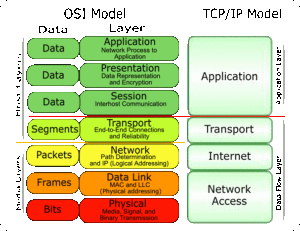 Communication systems require a set of rules to operate and enable interoperability between them; this set of rules is called protocols. There are two types of models that are used by modern communication systems. These models are the foundation of the internet. The two models are:
Communication systems require a set of rules to operate and enable interoperability between them; this set of rules is called protocols. There are two types of models that are used by modern communication systems. These models are the foundation of the internet. The two models are:
- Open system interconnection (OSI)
- Transmission control protocol/internet protocol (TCP/IP)
OSI
The OSI or open system interconnection is a communication protocol consisting of 7 layers that depend on each other for the effective functioning of a communication system. Used heavily in telecommunication and computing systems, the model standardizes and characterizes their communication functions regardless of the technology or structure being used.
The main aim of OSI is to provide a standard protocol for different types of communication systems. In OSI, the layer below is dependent on the layer below it and it caters to the layer above it. Let’s take a look at the 7 layers in OSI.
- Physical layer:
This layer is concerned with the transmission of raw data over a physical medium. It establishes a relationship between the medium and the communicating device. A physical medium might be a copper cable like twisted pair, Ethernet or coaxial or it can also be fiber optic which uses light to transmit data. Radio waves are also included in this layer.
- Data link layer:
It involves the transfer of data between two or more nodes over the physical medium. It includes error correction, flow control, and frame synchronization as well.
- Network layer:
In this layer, data is transferred between the source and destination nodes on the same network. This is done through logical addresses known as IP or internet protocol addresses.
- Transport layer:
It establishes the transmission of data between nodes that exist between two or more networks. Error control, flow control, quality of service, and message segmentation and desegmentation are carried out.
- Session layer:
This layer is responsible for controlling connections or sessions between two or more systems. It generates, manages, and ends the connections between the remote and local application.
- Presentation layer:
In this layer, data is formatted to be presented to the application layer. It carries out data encryption, decryption, compression, conversion, etc.
- Application layer:
It serves as a bridge between end users and software applications to access the various network functions.
TCP/IP
The transmission control protocol/internet protocol is a model that uses 4 layers and is the communication protocol that drives the internet. It is also utilized in intranets and extranets. It combines the various layers of OSI .Let’s take a quick look at the 4 layers.
- Network layer:
It combines the physical and data link layers of the OSI model and establishes data transference between hosts on the same network.
- Internet layer:
Combining the data link and network layer of the OSI model, it allows for communication between multiple networks, thus establishing internetworking or the internet.
- Transport layer:
Using the transport layer of the OSI model, it permits data to be transmitted between hosts on either the same network or different network.
- Application layer:
It combines the session, presentation, and application layers of the OSI model. It is responsible for providing the channel for interaction between software applications and end users.

